Welcome to Jupiter: NASA spacecraft Juno reaches giant planet
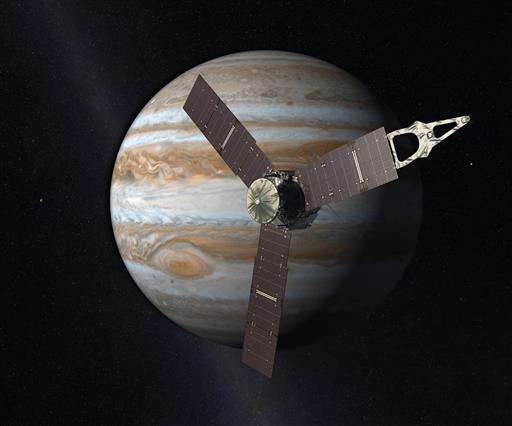
Braving intense radiation, a NASA spacecraft reached Jupiter on Monday after a five-year voyage to begin exploring the king of the planets.
Ground controllers at the NASA Jet Propulsion Laboratory and Lockheed Martin erupted in applause when the solar-powered Juno spacecraft beamed home news that it was circling Jupiter's poles.
The arrival at Jupiter was dramatic. As Juno approached its target, it fired its rocket engine to slow itself down and gently slipped into orbit. Because of the communication time lag between Jupiter and Earth, Juno was on autopilot when it executed the tricky move.
"Juno, welcome to Jupiter," said mission control commentator Jennifer Delavan of Lockheed Martin, which built Juno.
Mission managers said early reports indicated Juno was healthy and performed flawlessly.
"Juno sang to us and it was a song of perfection," JPL project manager Rick Nybakken said during a post-mission briefing.
The spacecraft's camera and other instruments were switched off for arrival, so there weren't any pictures at the moment it reached its destination. Afterward, NASA released a time-lapse video taken last week during the approach, showing Jupiter glowing yellow in the distance and its four inner moons dancing around it.
The view yielded a surprise: Jupiter's second-largest moon, Callisto, appeared dimmer than initially thought. Scientists have promised close-up views of the planet when Juno skims the cloud tops during the 20-month, $1.1 billion mission.
The fifth rock from the sun and the heftiest planet in the solar system, Jupiter is what's known as a gas giant—a ball of hydrogen and helium—unlike rocky Earth and Mars.
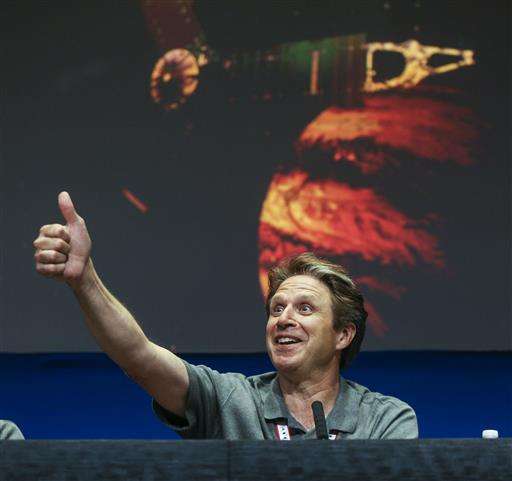
With its billowy clouds and colorful stripes, Jupiter is an extreme world that likely formed first, shortly after the sun. Unlocking its history may hold clues to understanding how Earth and the rest of the solar system developed.
Named after Jupiter's cloud-piercing wife in Roman mythology, Juno is only the second mission designed to spend time at Jupiter.
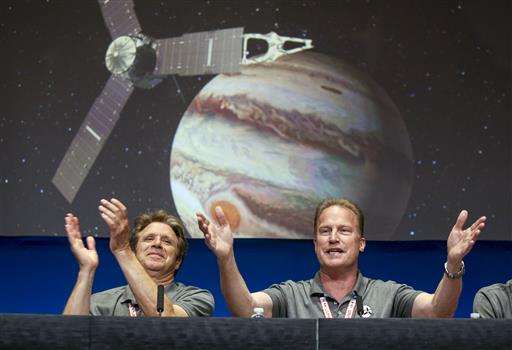
Galileo, launched in 1989, circled Jupiter for nearly a decade, beaming back splendid views of the planet and its numerous moons. It uncovered signs of an ocean beneath the icy surface of the moon Europa, considered a top target in the search for life outside Earth.
Juno's mission: To peer through Jupiter's cloud-socked atmosphere and map the interior from a unique vantage point above the poles. Among the lingering questions: How much water exists? Is there a solid core? Why are Jupiter's southern and northern lights the brightest in the solar system?
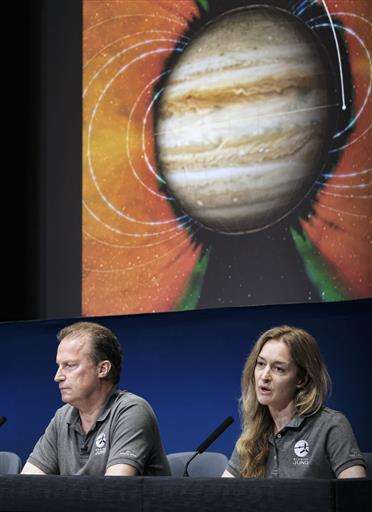
"What Juno's about is looking beneath that surface," Juno chief scientist Scott Bolton said before the arrival. "We've got to go down and look at what's inside, see how it's built, how deep these features go, learn about its real secrets."
There's also the mystery of its Great Red Spot. Recent observations by the Hubble Space Telescope revealed the centuries-old monster storm in Jupiter's atmosphere is shrinking.
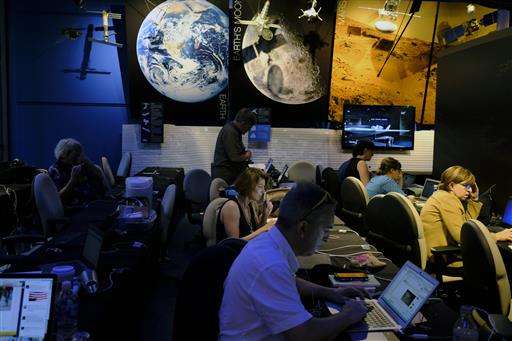
The trek to Jupiter, spanning nearly five years and 1.8 billion miles (2.8 billion kilometers), took Juno on a tour of the inner solar system followed by a swing past Earth that catapulted it beyond the asteroid belt between Mars and Jupiter.
Along the way, Juno became the first spacecraft to cruise that far out powered by the sun, beating Europe's comet-chasing Rosetta spacecraft. A trio of massive solar wings sticks out from Juno like blades from a windmill, generating 500 watts of power to run its nine instruments.
In the coming days, Juno will turn its instruments back on, but the real work won't begin until late August when the spacecraft swings in closer. Plans called for Juno to swoop within 3,000 miles (5,000 kilometers) of Jupiter's clouds—closer than previous missions—to map the planet's gravity and magnetic fields in order to learn about the interior makeup.
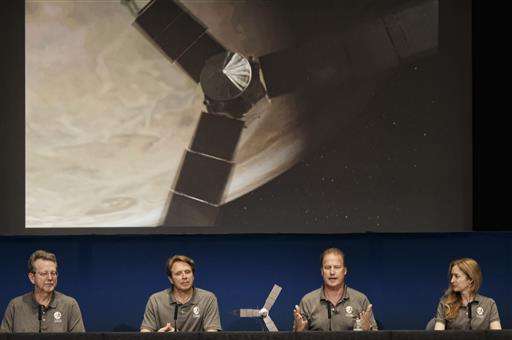
Juno is an armored spacecraft—its computer and electronics are locked in a titanium vault to shield them from harmful radiation. Even so, Juno is expected to get blasted with radiation equal to more than 100 million dental X-rays during the mission.
Like Galileo before it, Juno meets its demise in 2018 when it deliberately dives into Jupiter's atmosphere and disintegrates—a necessary sacrifice to prevent any chance of accidentally crashing into the planet's potentially habitable moons.
-
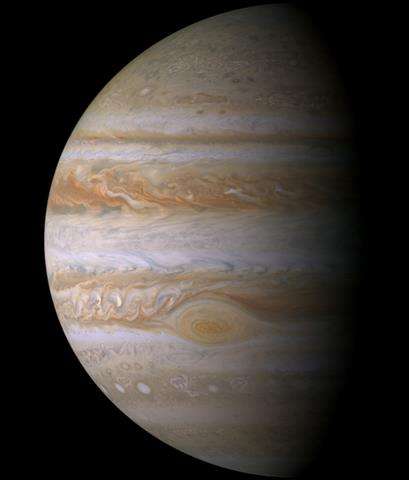
This composite image of photographs made by NASA's Cassini spacecraft on Dec. 29, 2000 shows the planet Jupiter. The photographs taken during the Cassini's closest approach to the gas giant at a distance of approximately 10 million kilometers (6.2 million miles). The Great Red Spot, a fierce storm larger than Earth, has been observed for centuries. But in recent years, it has been mysteriously shrinking. (NASA/JPL/Space Science Institute via AP) -
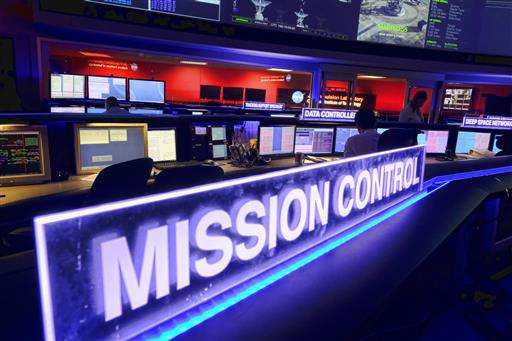
Data Controller Nick Lam, monitors the Juno spacecraft inside Mission Control in the Space Flight Operations Facility at Jet Propulsion Laboratory, in Pasadena, Calif., Monday, July 4, 2016. NASA's Juno spacecraft will fire its main rocket engine late Monday to slow itself down from a speed of 150,000 mph (250,000 kph) and slip into orbit around Jupiter. The solar-powered spacecraft is spinning toward Jupiter for the closest encounter with the biggest planet in our solar system. (AP Photo/Richard Vogel) -
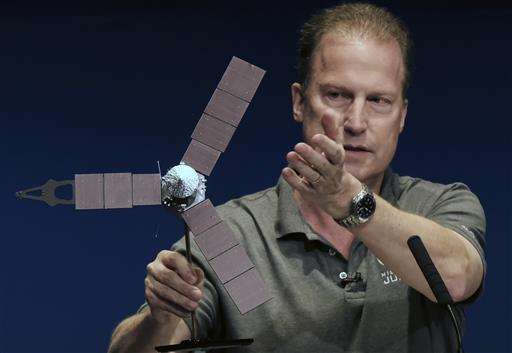
Rick Nybakken, Juno project manager, holds a model of the Juno spacecraft while talking about the solar panels and the orbit it will take around Jupiter during a briefing at the Jet Propulsion Laboratory in Pasadena, Calif., on Monday, July 4, 2016. The solar-powered spacecraft is on it's way toward Jupiter for the closest encounter with the biggest planet in our solar system. NASA's Juno spacecraft will fire its main rocket engine late Monday to slow itself down from a speed of 150,000 mph (250,000 kph) and slip into orbit around Jupiter. (AP Photo/Richard Vogel) -
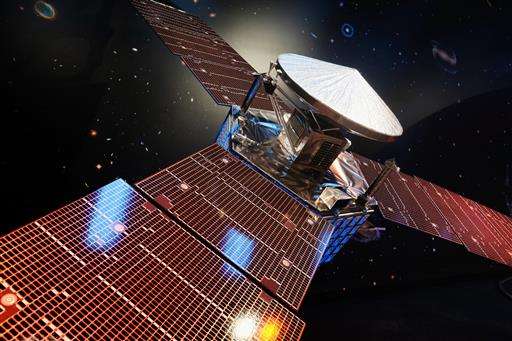
A 1/5 scale model size of NASA's solar-powered Juno spacecraft is displayed at the Jet Propulsion Laboratory in Pasadena, Calif. on Friday, July 1, 2016. The spacecraft is on the final leg of a five-year, 1.8 billion-mile voyage to the biggest planet in the solar system. It's expected to reach Jupiter and go into orbit around the planet on July 4. (AP Photo/Richard Vogel) -
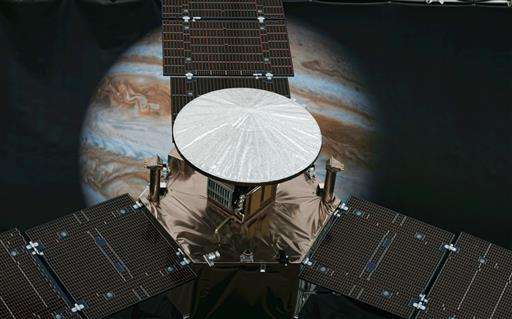
A 1/4 scale model size of NASA's solar-powered Juno spacecraft is displayed at the Jet Propulsion Laboratory in Pasadena, Calif. on Friday, July 1, 2016. The spacecraft is on the final leg of a five-year, 1.8 billion-mile voyage to the biggest planet in the solar system. It's expected to reach Jupiter and go into orbit around the planet on July 4. (AP Photo/Richard Vogel) -

Data Controller Nick Lam, monitors the Juno spacecraft inside Mission Control in the Space Flight Operations Facility at Jet Propulsion Laboratory, in Pasadena, Calif., Monday, July 4, 2016. NASA's Juno spacecraft will fire its main rocket engine late Monday to slow itself down from a speed of 150,000 mph (250,000 kph) and slip into orbit around Jupiter. The solar-powered spacecraft is spinning toward Jupiter for the closest encounter with the biggest planet in our solar system. (AP Photo/Richard Vogel) -
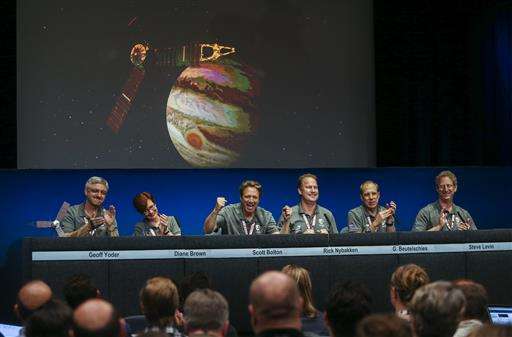
From left to right, Goeff Yoder, Diane Brown, Scott Bolton, Rick Nybakken, Guy Beutelschies, and Steve Levin participate in a post-orbit insertion briefing at NASA's Jet Propulsion Laboratory following the solar-powered Juno spacecraft entered orbit around Jupiter on Monday, July 4, 2016 in Pasadena, Calif. (AP Photo/Ringo H.W. Chiu) -
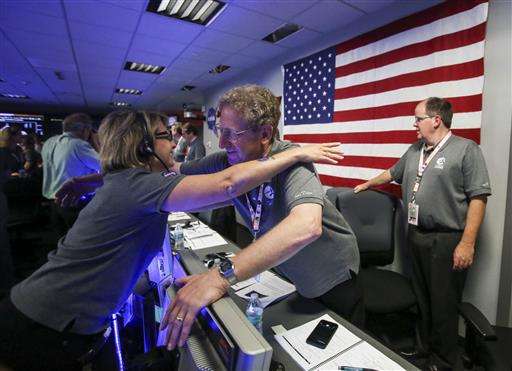
Marla Thornton, left, celebrates with Steve Levin in Mission Control at NASA's Jet Propulsion Laboratory as the solar-powered Juno spacecraft goes into orbit around Jupiter on Monday, July 4, 2016, in Pasadena, Calif. (AP Photo/Ringo H.W. Chiu, Pool) -
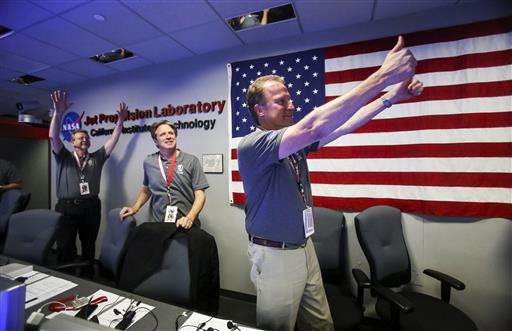
Michael Watkins, right, Scott Bolton, center, and Jim Green react in Mission Control at NASA's Jet Propulsion Laboratory as the solar-powered Juno spacecraft goes into orbit around Jupiter on Monday July 4, 2016 in Pasadena, Calif. (AP Photo/Ringo H.W. Chiu, Pool) -
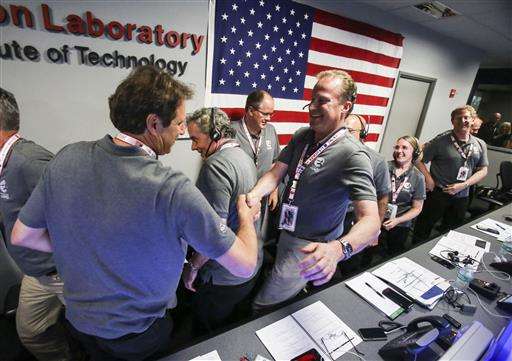
Scott Bolton, left, celebrates with Michael Watkins in Mission Control at NASA's Jet Propulsion Laboratory as the solar-powered Juno spacecraft goes into orbit around Jupiter on Monday, July 4, 2016, in Pasadena, Calif. (AP Photo/Ringo H.W. Chiu, Pool)
More information: Mission page: tinyurl.com/Jupitermission
© 2016 The Associated Press. All rights reserved.





















